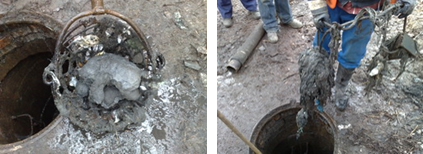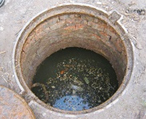maintenance of house sewerage systems
Purpose of Apartment Building Sewerage System
The building sewerage systems are intended for the following:
- uninterrupted removal of wastewater from plumbing fittings and fixtures into external sewerage network; and
- removal of rainwater (storm water drainage usually installed in flat roof buildings).
Typically, a sewerage system comprises discharge piping, stacks and discharges, cleanouts, inspection eyes etc.
schematic diagram of apartment building sewerage system
CAUTION! A diagram of sewerage networks should be available as part of a set of documents for each apartment building. Where such diagram is absent, steps should be taken to prepare it independently.
From time to time, disagreements arise between the joint owners of apartment buildings and the contractors providing maintenance of house and external water supply and sewerage systems with regard to their respective areas of responsibility.
Such situations are caused by lack of users’ awareness about the boundaries and zones of networks according to their book delimitation.
There are, however, regulatory documents, which cover and clearly regulate those issues.
Regulatory Documents Governing Maintenance of Sewerage Networks
The key documents, which prescribe the maintenance procedures of sewerage networks, are as follows:
1. Operational Regulations of Water Supply and Sewerage Systems in Population Centers of Ukraine. The Order of the State Committee of Ukraine for Housing and Communal Services of 5 July 1995, #30
2. On Approving the Regulations for Maintenance of Residential Buildings and Adjacent Territories. The Order of the State Committee of Ukraine for Housing and Communal Services of 17 May 2005, #76
Analysis of these regulations allows one to conclude that the end of the discharge pipe in the first sewer manhole after the building is the boundary of the internal house sewerage system.
Therefore, if network blockages or damages occur upstream of the first sewer manhole after the building, it is an HOA or housing management organization that shall bear operational responsibility.
If blockage or damages of networks occur downstream of the first sewer manhole after the building, it is a municipal water and sewer utility that shall bear operational responsibility.
The networks, related valves, fittings and fixtures located within the building are all parts of the house system and shall be serviced by contractors providing the services of maintenance of buildings, structures, and adjacent territories.
What Are the Causes of Sewerage Problems?
Досить часто мешканці міст скаржаться на зношеність каналізаційних мереж, засмічення, затоплені підвали і приміщення.
Signs of faulty sewerage system:
- unpleasant odors in bathrooms and kitchens;
- unpleasant odors coming from basements, and leakages;
- poor water drainage;
- emergence of air holes and leaks.

Basement Flooding with Wastewater
The main causes of faults in sewerage system operation include:
- contamination with human and animal hair, which forms tangles retaining waterborne solids;
- fat particles dissolved in the wastewater flowing from kitchen sinks and dishwashers, which harden after cooling and stick to piping walls;
- entry of large objects into drains, which could block sewage pipes;
- unauthorized repairs of sewerage system sections without adhering to the standards regarding inclination angles or pipe diameters;
- errors in system design
- wastewater volume in excess of system’s design parameters.
The experience shows that the majority of complaints relate to the need of removing mechanical blockages resulting from inappropriate use of sewerage networks.
Unfortunately, for reasons unknown, some citizens fail to understand that municipal sewerage system is not a garbage chute.
It is strongly forbidden to put the following into sewer system:
- personal hygiene products;
- rags and towels;
- stuffed toys;
- solid household waste;
- building materials etc.
Somehow it is specifically those objects that “accidentally” get in the sewers, resulting in solid mechanical blockages, which lead to flooding of basements or apartments located on lower floors of apartment buildings.

Examples of Mechanical Blockages of Sewerage System
Frequent occurrence of such leaks and insufficiently rapid response to those by service providers force the residents of lower floors to intervene themselves in operation of wastewater removal system.
In order to prevent any future flooding, they either stop water supply by shutting off water-intake valves or open covers of inspection eyes of wastewater pipes in basements of their buildings, which results in the loss of system integrity.

Open Cover of Sewerage System’s Inspection Eye
Such interference leads to flooding of apartment building basements with soil water and unpleasant odors in lobbies.
How to Get Rid of Sewerage Problems
1. Regular inspections and cleaning (if needed) of sewerage systems.
2. Ban on immuring of inspection holes.
3. Use mesh on kitchen sinks, wash sinks, bathtubs, and showers, so as to trap larger solids, human and animal hair etc.
4. Timely elimination of any leakages and replacement (if needed) of faulty piping sections.
After years in service, sewer manholes are not in a very good condition; however, given appropriate operation of the external sewerage system, they should look as shown in Fig.1.
In case of any mechanical blockage in the network, a sewer manhole would look something like this (Fig. 2). When a sewerage system is blocked, at best, the manhole is at backflow, or at worst, wastewater runs out onto sidewalk, motorway or flows into apartment building basement in case of sewerage system’s loss of integrity.
 |
 |
| Fig.1 Clean Manhole | Fig.2 Manhole at Backflow |
Essential HOA Actions
1. Make a contract with companies, which have emergency maintenance crews and dispatch service for maintenance of sewerage systems (typically, this contract also covers maintenance of water supply and other systems).
2. Inform the residents about the rules of using the sewerage systems and the need of observing the sewerage system installation rules during any renovations in apartments.
3. In case of any damages and/or when detecting signs of poor functioning of sewerage system, contract for its repair/cleaning/reconstruction.
Value your home and use building services for their intended purpose only!









